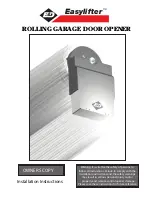
5. INSTALLING THE AUTOMATED SYSTEM
5.1. PRELIMINARY CHECKS
To ensure safety and an efficiently operating automatic system, make sure
the following conditions are observed:
• The structure of the door must be suitable to be automated. Specifically,
the wheel diameter must be in relation to the weight of the gate to be
automated; an upper guide must be present; travel-limit mechanical
stops must be fitted to prevent the gate derailing.
• The soil must permit sufficient stability for the foundation plinth.
• There must be no pipes or electrical cables in the plinth excavation area.
• If the gearmotor is exposed to passing vehicles, install, if possible, adequate
means of protection against accidental impact.
• Check if an efficient earth socket is available for connecting the gearmotor.
• Make sure that there is sufficient space around the operator to enable all
the installation jobs and subsequent maintenance work to be smoothly
carried out.
5.2. MASONRY FOR FOUNDATION PLATE
1. Assemble the foundation plate as
in Fig. 4.
2. The foundation plate must be locat-
ed as shown in Fig. 5 (right closing)
or Fig. 6 (left closing) to ensure
correct meshing between rack
and pinion.
When positioning the plate, leave
the Ø 80 hole for routing the
sheaths on the left, as shown
in Fig. 5-6 ref.
.
5.3. MECHANICAL INSTALLATION
Remove the motor cover, fully unscrewing the 2 upper securing screws
(Fig. 8 ref.
).
Rotate the cover by about 30° and pull upward.
Withdraw the 2 lateral protective devices (Fig.8 ref.
).
Fit the operator on the plate, using the
supplied washers and nuts as shown
in Fig.9.
During this operation, route the cables
through the slot on the operator’s reduc-
tion element .
Adjust the height of the feet and the
distance from the gate - refer
to Fig. 10.
This operation is necessary to secure
the rack correctly and to enable you, in
future, to make any height adjustments
to the motor.
Tighten the gearmotor securing screws.
Prepare the operator for manual operation as described in chapter 8.
5.4. INSTALLING THE RACK
5.4.1. STEEL RACK TO BE WELDED (F
IG
.11)
Fit the three threaded pawls on the rack
element, positioning them on the upper part
of the slot. In this way the clearance on the
slot will enable any adjustments long-term.
Manually move the leaf to its opening
position.
Lay the first piece of rack level on the pinion
and weld the threaded pawl on the gate
as shown in Fig.13.
Manually move the gate, checking if the
rack is resting on the pinion and weld the
second and third pawls.
Fit another rack element next to the previous one, using a piece of rack,
as shown in Fig.14 ref.
, to synchronise the teeth of the two elements.
Move the gate manually and weld the three threaded pawls. Carry on
like this until you have fully covered the gate.
Do not allow any superfluous sections of rack to project from the
gate.
3. Make a foundation plinth as in Fig. 7 and wall the foundation plate, pro-
viding one or more sheaths for routing the electrical cables. Using a spirit
level, check if the plate is perfectly level. Wait for the cement to set.
4. Prepare the electrical cables for connection to the accessories and the
electrical power supply as shown in Fig. 3.
To facilitate making the connections, make the cables come out by about
40 cm from the foundation plate hole (Fig. 5-6 ref.
).
Fig. 8
Fig. 5
Fig. 6
Fig. 7
Fig. 4
Fig. 9
Fig. 10
Fig. 11
FALCON M
8
00058I0616 - Rev.1
Tr
ansla
tion of the original instruc
tions
ENGLISH
Содержание falcon m
Страница 1: ...FALCON M...
Страница 26: ...FALCON M_Utente 8 00058I0616 Rev 1...
Страница 41: ...FALCON M_Utente 8 00058I0616 Rev 1...
Страница 42: ...FALCON M_Utente 8 00058I0616 Rev 1...











































